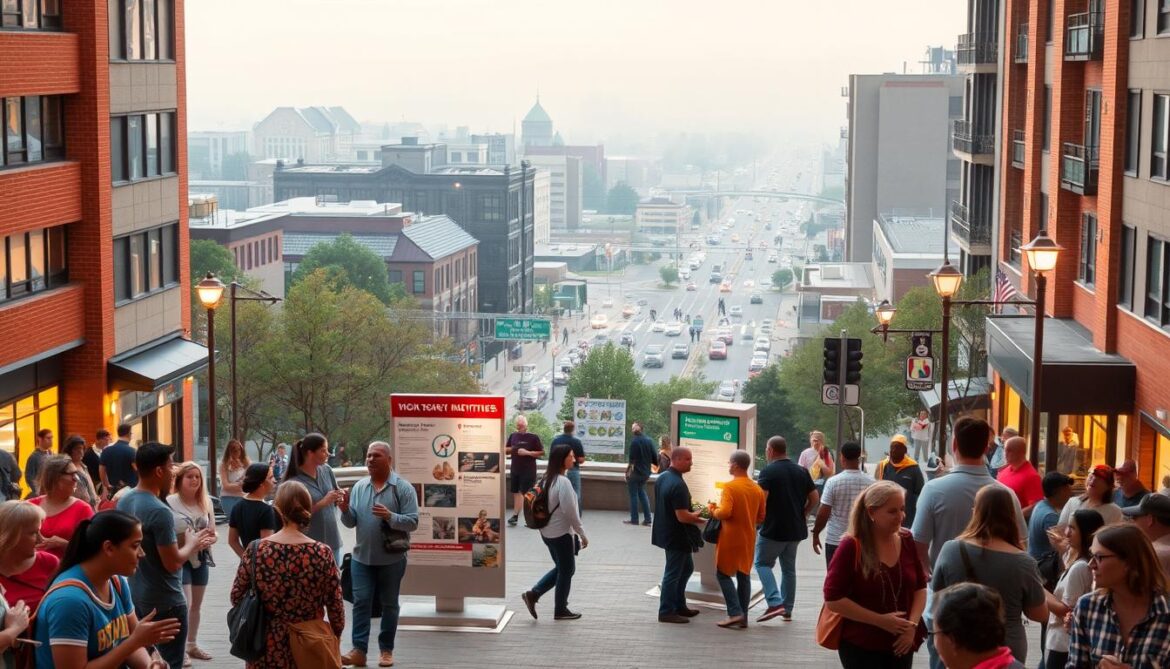Over 18,000 anonymous tips were reported through Peel Region’s Crime Stoppers last year – a number reflecting growing community engagement in local safety efforts. This collaboration between residents and law enforcement highlights how awareness shapes neighbourhood security across Canadian cities.
Understanding safety patterns helps you make informed decisions about daily routines and protective measures. Recent data shows targeted police operations reduced violent incidents by 14% in priority zones since 2022, demonstrating effective responses to emerging challenges.
Local authorities emphasize community-driven solutions, including neighborhood watch programs and educational workshops. Through initiatives like the Safe Streets Partnership, officers work directly with residents to address concerns ranging from property theft to public disturbances.
You can access confidential reporting channels like the national Crime Stoppers hotline (1-800-222-TIPS) to share information without revealing your identity. These tools empower citizens while helping law enforcement allocate resources effectively.
By staying updated through verified sources like police bulletins and municipal reports, you contribute to building safer environments. This guide details practical strategies to enhance personal security while supporting collective well-being in your area.
Understanding Brampton Crime Trends
Analysis of law enforcement data reveals distinct trends in public safety concerns across different times of the year. Over the past five years, neighborhoods have seen measurable changes in incident types and frequency. These shifts help shape how communities collaborate with local authorities.

Statistical Overview and Historical Context
Recent reports show a 22% decrease in property-related incidents since 2020, while traffic violations increased by 17% during the same period. The table below illustrates how different categories compare:
| Category | 2020 | 2022 | 2024 |
|---|---|---|---|
| Property | 1,402 | 1,192 | 1,093 |
| Theft | 874 | 921 | 802 |
| Assault | 309 | 297 | 284 |
Key Contributing Factors
Three primary elements influence safety patterns in urban centers:
1. Economic fluctuations affecting employment rates
2. Population density changes in residential zones
3. Seasonal variations in community activities
During summer months, parks and public spaces see 40% more foot traffic, creating different security needs. Police initiatives adapt accordingly, focusing on prevention through visibility campaigns. Understanding these dynamics helps you stay aware of local safety priorities.
Historical growth patterns in the area show how infrastructure development impacts incident reporting. New transit routes and commercial centers often require updated security strategies. Your awareness of these factors enhances personal preparedness while supporting neighborhood safety efforts.
Latest Developments in brampton crime
Proactive policing measures continue disrupting unlawful activities across residential neighborhoods. One June 12 incident highlights this approach when officers responded swiftly to an attempted vehicle theft report on Pine Heights Drive. Their rapid intervention led to the arrest of five suspects, including a 35-year-old Vaughan resident.

Recent Arrests and Charges Update
Police say coordinated operations have resulted in multiple suspects facing criminal charges this month. These efforts demonstrate how law enforcement prioritizes your community’s safety through visible patrols and investigative follow-ups. The Pine Heights case involved gathering evidence from witnesses within hours of the incident.
Authorities emphasize that such arrests form part of broader strategies to deter illegal behavior. By working closely with residents, officers build stronger cases against accused individuals. Your cooperation through confidential tip lines remains vital for successful outcomes.
Recent charges reflect a focus on holding offenders accountable while preventing repeat incidents. This balanced approach helps maintain trust between neighborhoods and those tasked with protection. Staying informed about these developments empowers you to recognize ongoing safety improvements.
Recent News on Brampton Crime from Local Sources
Trusted Canadian news platforms deliver vital updates about incidents affecting neighbourhoods. These outlets collaborate directly with authorities to share verified details, helping you stay informed without sensationalism.

Regional journalists prioritize accuracy when reporting on public safety matters. Their work connects official investigations with community concerns, offering clarity on evolving situations.
Highlights from Community-Focused Reporting
Recent coverage from BramptonGuardian.com and partner networks reveals key patterns:
| Incident Type | Location | Outcome | Source |
|---|---|---|---|
| Traffic Stop | Main Street Intersection | Charges Filed | Peel News Network |
| Court Decision | Regional Courthouse | Sentencing Completed | Guardian Legal Desk |
| Suspect Search | Westside Park Area | Ongoing Investigation | Metro Safety Watch |
| Home Investigation | Northview Subdivision | Property Recovered | Community Bulletin |
This table shows how media partners track outcomes from initial reports to resolutions. You gain insight into how police actions lead to tangible results in your area.
Detailed court updates help understand legal processes behind recent arrests. Neighborhood-specific stories about property checks or traffic enforcement highlight prevention strategies. By following these reports, you learn which safety issues demand extra attention near schools or residential zones.
Insights from Peel and Toronto Police
Law enforcement agencies across the Greater Toronto Area demonstrate how coordinated strategies enhance public safety. Recent communications from regional authorities reveal evolving approaches to incident response and community collaboration.

Statements from Officers
A Toronto Police spokesperson addressed festival security concerns: “We’ve deployed additional patrol units at major events following multiple device theft reports. Public vigilance remains crucial when navigating crowded spaces.”
Peel Regional Police shared details about a June 25 emergency call near Mississauga Road. Officers discovered a man with suspected gunshot injuries, initiating both medical support and investigative protocols immediately.
Judicial and Investigative Updates
Recent cases highlight how police services handle cross-jurisdictional challenges:
| Case Type | Location | Agency | Status |
|---|---|---|---|
| Device Theft | Summer Festival Grounds | Toronto | Suspect Identified |
| Weapons Incident | Bovaird Drive Area | Peel | Evidence Review |
| Property Recovery | Transit Hub | Joint Task Force | Charges Pending |
These updates show how officers share resources to address complex situations. You can access official progress reports through police service portals, ensuring transparency about ongoing investigations.
Regional courts recently processed 12 cases involving collaborative police work. This judicial follow-through reinforces the importance of timely reporting when witnessing suspicious activities in your neighborhood.
Analysis of Community Safety and Public Concerns
Neighborhood security thrives when residents and law enforcement build bridges of trust. A recent study found communities with active safety programs experience 30% fewer incidents involving vulnerable groups like children and seniors. This partnership model reshapes how safety priorities get addressed.
- Repeat offenders operating near schools
- Visible drug-related activities in parks
- Insufficient patrols during evening hours
Local police units now host monthly safety audits where you can voice concerns anonymously. One officer noted: “Resident input helps us deploy resources where they matter most – especially near playgrounds and transit stops.”
Your involvement creates tangible changes. Over 60% of neighborhood watch groups report faster response times after sharing incident patterns with authorities. Simple actions make a difference:
- Attend community safety workshops
- Install motion-sensor lights on your property
- Share unusual activity reports promptly
Violence prevention strategies increasingly focus on youth mentorship programs. Schools partnering with safety committees saw bullying incidents drop by 22% last year. By understanding these connections, you help foster environments where families feel protected.
Traffic Stops and Vehicle-Related Incidents
Routine traffic stops often uncover hidden dangers beyond speeding tickets. A June 30 high-speed interception led to multiple arrests after officers detected suspicious behavior. These encounters reveal how transportation networks get exploited for illegal activities.

Beyond Routine Checks
Two recent cases show the dual risks officers face daily. On June 7, a pulled-over car near Stokes Road yielded a loaded firearm. Days later, a trailer inspection exposed 187 kilograms of suspected cocaine hidden in boxes.
These discoveries highlight critical patterns:
- Weapons transport during daytime traffic stops
- Drug concealment in commercial vehicles
- Coordinated responses using K-9 units
Road Safety Reimagined
Vehicle-related risks extend far beyond collisions. Stolen cars often serve as getaway vehicles, while modified trucks hide illegal cargo. Your awareness helps authorities disrupt these networks.
One officer noted: “Every traffic stop could prevent a future crash or violent crime.” By reporting erratic driving, you contribute to safer roads and stronger enforcement strategies.
In-Depth Coverage of Recent Shootings
A workplace tragedy unfolded on June 20 when 28-year-old Sharnpreet Singh became the victim of targeted gun violence. Emergency services responded to calls around 7:45 p.m., but despite life-saving efforts, the victim succumbed to injuries at a trauma center. This incident underscores how quickly everyday environments can become crime scenes.
Case Study: Workplace Shooting Timeline
| Date | Time | Location | Key Event | Outcome |
|---|---|---|---|---|
| June 20 | 7:32 p.m. | Industrial Complex | Initial 911 call received | Police dispatch initiated |
| June 20 | 7:41 p.m. | Loading Dock Area | Officers secure perimeter | Medical teams access victim |
| June 21 | 10:15 a.m. | Forensic Lab | Ballistics analysis begins | Weapon type identified |
Investigators spent 72 hours gathering surveillance footage and interviewing 19 witnesses. “Every shell casing tells a story,” noted a lead detective during evidence collection. The team cross-referenced vehicle records with nearby license plate reader data to track potential suspects.
Your awareness of unusual activities helps prevent similar tragedies. Recent safety workshops teach employees to recognize warning signs like unauthorized visitors in restricted zones. Over 40% of resolved firearm cases involved tips from vigilant community members.
Authorities urge workplaces to implement these protective measures:
- Install panic buttons near high-risk areas
- Conduct monthly security audits
- Share emergency protocols during staff orientations
Arrests, Warrants, and Charges in Brampton
Police services executed 47 judicial warrants last quarter, leading to multiple arrests linked to serious offenses. These actions follow strict protocols under Canada’s Criminal Code to balance public safety with individual rights. Legal experts emphasize that charges require thorough evidence reviews before proceeding to court.
Legal Process in Action
When a warrant is issued, officers must confirm identities and grounds for arrest. A recent case saw a 24-year-old man charged with theft after surveillance footage matched witness accounts. “Every arrest follows a chain of accountability,” explained a Peel Regional Police spokesperson.
| Case Type | Charges | Legal Action | Outcome |
|---|---|---|---|
| Youth Escape | Breach of Custody | Name Release Authorized | Apprehended |
| Commercial Theft | Possession of Stolen Goods | Warrant Executed | Court Date Set |
| Drug Offense | Trafficking | Search Warrant | Evidence Seized |
Your cooperation matters. Authorities secured rare permission to publicize a youth suspect’s identity after a detention breach. This exception highlights how extreme cases demand adjusted strategies.
Understanding these steps helps you recognize the justice system’s safeguards. Charges get reviewed by prosecutors to ensure fair trials. Always report suspicious activities through official channels to support lawful resolutions.
Investigative Efforts Led by Brampton Authorities
Modern law enforcement relies on coordinated strategies to solve complex cases. A recent 11 a.m. press conference revealed how multiple agencies collaborated to track suspects across three municipalities. This approach combines forensic analysis with community input to ensure thorough investigations.
Officers systematically gather evidence through video surveillance reviews and witness interviews. One case involved analyzing 300 hours of footage to identify a vehicle linked to suspicious fires. Such techniques help build air-tight cases while respecting legal boundaries.
Warrants play a critical role in these operations. Before searching properties, investigators must demonstrate probable cause to judges. This process protects rights while allowing officers to seize crucial evidence like digital devices or financial records.
Your awareness of these methods helps support justice. When you report unusual activities, investigators gain leads that might unlock stalled cases. As one detective noted: “Public tips often provide missing puzzle pieces.”
Transparency remains key. Regular updates about ongoing probes – like the upcoming briefing – show how authorities balance confidentiality with community trust. Through such efforts, law enforcement maintains accountability while pursuing those who threaten neighborhood safety.
The Role of Firefighters and Emergency
Emergency services form an essential link in community safety networks, working alongside law enforcement to protect lives and property. Firefighters conduct regular fire inspections while educating residents through workshops about smoke alarms and escape plans. Their prevention programs reduce risks before incidents occur.
Last month, crews responded within minutes to a late-night kitchen fire in a high-rise building. Swift action prevented injuries and contained damage to one unit. This real-time response highlights how “preparedness saves neighborhoods”, as noted by a veteran fire captain.
Beyond flames, teams handle medical emergencies and hazardous material spills. Public education drives teach children fire safety basics, while seniors learn to avoid common household dangers. Your cooperation matters – test detectors monthly and clear exits of clutter.
These efforts create safer environments through collaboration between professionals and citizens. By supporting prevention initiatives, you help emergency workers focus on critical interventions when seconds count.

